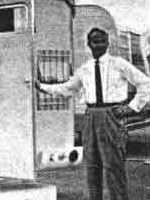I'm not sure these are all the appropriate images to the Wanderer but they were originally labeled as such by Andrew enough that they came up in the search results.
_______________________________________
THE WANDERER 8 AND 10(from no longer online web page:
http://www.angib.pwp.blueyonder.co.uk/t ... tear59.htm)
The Wanderer design is intended as the largest trailer body that can be safely mounted on a Harbor Freight 4x8 utility trailer kit. The name comes from two designs that inspired it, the Wander Bug and Wander Pup, both in the T&TTT Vintage Plans.
Weight The weight of the completed laden trailer has been estimated at about 1300lb for the 8 foot and 1400lb for the 10 foot body, which leaves a comfortable margin on the 1720lb payload rating (that is a 1980lb GVW rating when the trailer weight is added) of the HF ‘super duty’ 4x8 trailer. The 5.30-12 ‘C’ range tires of this trailer have a capacity of 2100lb per pair.
This margin could be easily eaten up if the trailer is built any heavier than shown. There is a good area of structure in this design, compared to a teardrop, and increasing the thickness or adding extra layers will quickly push the weight over the capacity of the trailer. A trailer’s weight is determined as much by how heavily each part is built as by the overall design and size, so do not build it any heavier than shown without working out the consequences.
The weight estimate can be downloaded as an Excel spreadsheet and used to test the effects of any changes in material thicknesses or sizes.
Size This design provides just about standing headroom in the dropped footwell and this can hide how small this trailer really is. So let’s be clear: only one person can stand up, they can’t lift their arms without hitting something and they cannot get in/out of the trailer without bending over. This is a tiny trailer, not a small trailer!
The body is just wide enough to allow beds to set across the width of the trailer and this allows many different layouts to be used. Two different body lengths, 8 feet and 10 feet, are shown and the 8 foot length may suit some people, but the weight and cost penalty of building at 10 foot is so small that it seems the sensible choice.
But this remains a tiny trailer and that needs to always be remembered. One 10 foot variant is shown with a compartment that can house a porta-potty but there isn’t standing headroom inside and there is no possibility of adding a shower.
The trailer without any roof vent is about 83” tall so it may fit in a standard 7 foot door. The underside of the dropped footwell is about 8.5” above the road – the same as the underside of the axle tube. Making the footwell 2” deeper and the body 2” lower would give the same headroom and allow a low profile roof vent to be added within the 83” height.
The trailer body may be tiny, but it’s still quite a bit bigger than the HF trailer under it, so towing speeds should be limited in windy conditions.
Trailer Modifications The Harbor Freight trailer kit does require several modifications for this design. These require cutting, drilling and bolting but welding is not required.
The axle is mounted above the springs, instead of below, in order to reduce the trailer deck height. To provide full bump clearance, part of the spring hangers must be cut away to allow the axle to nearly reach the frame rails.
In all layouts one or more cross-members are not fitted and the axle is not installed in the position originally intended by HF in order to give correct trailer balance.
In the 8 foot versions, the last 12” of the frame side rails are cut off and the rearmost cross-member relocated 12” forwards.
In the 10 foot versions, the trailer frame is lengthened 12” using two cross-members inserted inside the side rails. As the spring hanger will be fitted across the joint, some steel packing pieces may need to be added.
Body Construction This design is unusual in that it is entirely single-skinned – this is to save weight and to allow a fairly tough 1/4” skin. Insulation can be added to the inside between framing and some upholstery fabric glued, pinned and/or stapled to the inside for appearance.
The body overhangs the trailer frame substantially, but the floor is 1/2” ply with no framing. The whole body is supported by two 1x6 beams that lie right on top of the front and back frame cross-members. These beams are a vital part of the structure and must not be left out, cut or laid flat. During construction, a couple of braces should be added to adjacent structure, to prevent the middle of the beams from twisting.
The sidewall framing is laid ‘flat’ to give the maximum internal width, except at the door where it is turned ‘upright’ to give the maximum strength. The roof spars must all be ‘upright’ to span the 78” width and 2x2 nominal spars are used where the roof panel joints fall. These are the only 2x2 timber in the body. Only 1x2 and 1x1 nominal timber can be used elsewhere or the estimated weight will be exceeded.









 it would be great if you converted the hard copy you have and post it. The designs are an invaluable resource.
it would be great if you converted the hard copy you have and post it. The designs are an invaluable resource.